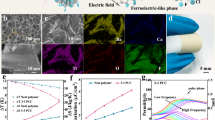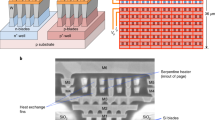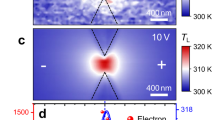Abstract
There is a significant need for site-specific and on-demand cooling in electronic1,2, optoelectronic3 and bioanalytical4 devices, where cooling is currently achieved by the use of bulky and/or over-designed system-level solutions. Thermoelectric devices can address these limitations while also enabling energy-efficient solutions, and significant progress has been made in the development of nanostructured thermoelectric materials with enhanced figures-of-merit5,6,7,8,9,10. However, fully functional practical thermoelectric coolers have not been made from these nanomaterials due to the enormous difficulties in integrating nanoscale materials into microscale devices and packaged macroscale systems. Here, we show the integration of thermoelectric coolers fabricated from nanostructured Bi2Te3-based thin-film superlattices into state-of-the-art electronic packages. We report cooling of as much as 15 °C at the targeted region on a silicon chip with a high (∼1,300 W cm−2) heat flux. This is the first demonstration of viable chip-scale refrigeration technology and has the potential to enable a wide range of currently thermally limited applications.
This is a preview of subscription content, access via your institution
Access options
Subscribe to this journal
Receive 12 print issues and online access
$259.00 per year
only $21.58 per issue
Buy this article
- Purchase on Springer Link
- Instant access to full article PDF
Prices may be subject to local taxes which are calculated during checkout



Similar content being viewed by others
References
Mahajan, R., Chiu, C.-P. & Chrysler, G. Cooling a microprocessor chip. Proc. IEEE 94, 1476–1486 (2006).
Prasher, R. S. et al. Nano and micro technology-based next-generation package-level cooling solutions. Intel Tech. J. 9, 285–296 (2005).
Semenyuk, V. A. in Thermoelectrics Handbook: Macro to Nano (ed. Rowe, D. M.) 58-1–58-20 (CRC Press, 2006).
Sanders, G. H. W. & Manz, A. Chip-based microsystems for genomic and proteomic analysis. Trends Anal. Chem. 19, 364–378 (2000).
Majumdar, A. Thermoelectricity in semiconductor nanostructures. Science 303, 777–778 (2004).
Venkatasubramanian, R., Siivola, E., Colpitts, T. & O'Quinn, B. Thin-film thermoelectric devices with high room-temperature figures of merit. Nature 413, 597–602 (2001).
Shakouri, A. Nano-scale thermal transport and microrefrigerators on a chip. Proc. IEEE 94, 1613–1638 (2006).
Zhang, Y. et al. Experimental characterization of bonded microcoolers for hot spot removal. Proc. InterPack 2005, July 17–22, San Francisco, CA, paper IPACK2005-73466 (2005).
Harman, T. C., Taylor, P. J., Walsh, M. P. & LaForge, B. E. Quantum dot superlattice thermoelectric materials and devices. Science 297, 2229–2232 (2002).
Poudel, B. et al. High-thermoelectric performance of nanostructured bismuth antimony telluride bulk alloys. Science 320, 634–638 (2008).
Borkar, S. Design challenges of technology scaling. IEEE Micro 19, 23–29 (1999).
Kaczer, B., Degraeve, R., Pangon, N. & Groeseneken, G. The influence of elevated temperature on degradation and lifetime prediction of thin silicon-dioxide films. IEEE Trans. Electron. Dev. 47, 1514–1521 (2000).
Zhimin, M., Anderson, J. & Liu, J. Integrating nano carbontubes with microchannel cooler. Proc. 6th IEEE High Density Microsystem Design and Packaging and Component Failure Analysis Conference, 30 June–3 July, Shanghai, China, 373–376 (2004).
Tuckerman, D. B. & Pease, R. F. W. High-performance heat sinking for VLSI. IEEE Electron. Dev. Lett. 2, 126–129 (1981).
Patel, C. D., Bash, C. E., Sharma, R., Beitelmal, A. & Malone, C. G. Smart chip, system and data center enabled by advanced flexible cooling resources. Proc. 21st IEEE Semi-Therm Symposium, 78–85 (2005).
Goldsmid, H. J. in CRC Handbook of Thermoelectrics (ed. Rowe, D. M.) 19–26 (CRC Press, 1995).
Mahajan, R., Chiu, C.-P. & Prasher, R. S. Thermal interface materials: a brief review of design characteristics and materials. Electron. Cooling 10, 10–18 (2004).
Goh, T. J., Seetharamu, K. N., Quadir, G. A, Zainal, Z. A. & Ganeshamoorthy, K. J. Thermal investigations of microelectronics chip with non-uniform power distribution: temperature prediction and thermal placement design optimization. Microelectron. Int. 21, 29–43 (2004).
Meysenc, L., Jylhäkallio, M. & Barbosa, P. Power electronics cooling effectiveness versus thermal inertia. IEEE Trans. Power Electron. 20, 687–693 (2005).
Pesaran, A., Vlahinos, A. & Stuart, T. Cooling and preheating of batteries in hybrid electric vehicles. Proc. 6th ASME-JSME Thermal Engineering Joint Conference, March 16–20, Hawaii Island, HI, paper TED-AJ03-633 (2003).
Acknowledgements
Authors from Intel would like to acknowledge the contributions of the late D. Chau, S. R. Cass, S. Devasenathipathy and J. B. Petrini. Authors from RTI International and Nextreme acknowledge the financial support of RTI International, Defense Advanced Research Projects Agency and Office of Naval Research, and the valuable contributions of B. O'Quinn and E. Siivola.
Author information
Authors and Affiliations
Corresponding authors
Supplementary information
Supplementary Information
Supplementary Information (PDF 344 kb)
Rights and permissions
About this article
Cite this article
Chowdhury, I., Prasher, R., Lofgreen, K. et al. On-chip cooling by superlattice-based thin-film thermoelectrics. Nature Nanotech 4, 235–238 (2009). https://doi.org/10.1038/nnano.2008.417
Received:
Accepted:
Published:
Issue Date:
DOI: https://doi.org/10.1038/nnano.2008.417
This article is cited by
-
Texture and Se vacancy optimization induces high thermoelectric performance in Bi2Se3 flexible thin films
Rare Metals (2024)
-
Half-Heusler alloys as emerging high power density thermoelectric cooling materials
Nature Communications (2023)
-
Evoking natural thermal perceptions using a thin-film thermoelectric device with high cooling power density and speed
Nature Biomedical Engineering (2023)
-
Thermoelectric properties plus phonon and de Haas–van Alphen frequencies of hole/electron-doped \(\hbox {CeIn}_3\)
Scientific Reports (2022)
-
Unexpected thermal conductivity enhancement in aperiodic superlattices discovered using active machine learning
npj Computational Materials (2022)



